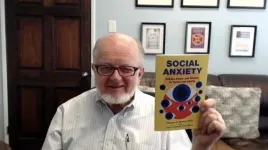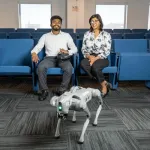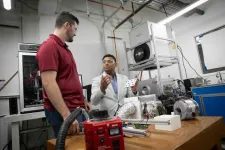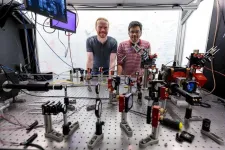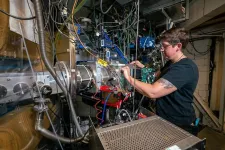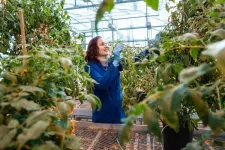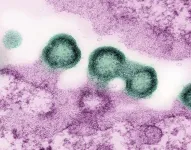(Press-News.org) RICHLAND, Wash.—Researchers at the Department of Energy’s Pacific Northwest National Laboratory have been awarded more than 3 million node hours on the nation’s most powerful computers to explore questions around pathogens, climate and energy-efficient microelectronics.
Access to the nation’s supercomputers, granted to Margaret Cheung, Daniel Mejia Rodriguez and Po-Lun Ma, is a coveted prize among scientists. The node hours represent an investment of several million dollars in computing time awarded to PNNL scientists to explore important science questions.
The awards are among 44 projects awarded through DOE’s 2024-2025 ASCR Leadership Computing Challenge from DOE’s Office of Advanced Scientific Computing Research. The program grants computational time at the Argonne Leadership Computing Facility, the Oak Ridge Leadership Computing Facility and the National Energy Research Scientific Computing Center.
The clash between pathogens and hosts
Margaret Cheung is using 1 million node hours of computing time to study how viruses infect algae—a process that offers clues for preparing for possible future pandemics. The virus-algae system is a window into the broader tug-of-war that happens constantly between pathogen and host. One only needs to hear about the latest strain of COVID to know that viruses mutate constantly, marking ever-changing targets. Cheung will use the resources of DOE’s most advanced computers, including the world’s fastest computer, Frontier at OLCF, as well as resources at ALCF and NERSC, to tease out the secrets of the pathogen vs. host battleground.
Cheung’s work is part of a program at PNNL known as predictive phenomics, a major effort where scientists make basic changes to molecular interactions and then monitor how those modifications change the organism. For several decades, scientists have known that an organism’s genes—its DNA—are extremely important. It’s turning out that there are many other more subtle biological processes that play a huge role in biology. Cheung’s exploration of such events in interactions between viruses and algae could provide a road map for understanding those same processes in people. The project has been supported by PNNL as well as DOE’s Biopreparedness Research Virtual Environment (BRaVE) initiative.
“We want to know exactly what’s happening between the pathogen and host—not just what’s happening but exactly when and where and how,” said Cheung. “This involves a great deal of fundamental physics and chemistry, even in algae and simple viruses.”
Aerosols and climate
Earth scientist Po-Lun Ma is focusing on better representing atmospheric aerosols in climate models. Aerosols—tiny particles that come naturally from sources like wildfires or sea spray as well as sources like pollution—are among the greatest sources of uncertainty in climate simulations. Scientists believe that aerosols can either cool or warm the planet, depending on circumstances. Ma leads a study known as EAGLES that has continually chipped away at the uncertainty, discovering important details about interactions between clouds and Earth’s atmosphere.
This marks the fourth time Ma has received the award—the three previous awards were also granted for EAGLES work. This year, the project was awarded 1.6 million node hours of computer time on Frontier.
“We’re proud of our work, but we’re not yet satisfied,” said Ma. “We get to help uncover important details that few others on the planet can, details that are key for making informed decisions about the climate-related challenges faced by nations and societies around the world.”
Spintronics and electronic efficiency
Computational scientist Daniel Mejia Rodriguez is working on making digital electronics more efficient. Currently, electronic processes consume an unsustainable amount of energy per operation. As a result, future technologies with drastically lower power consumption are necessary. One promising approach involves controlling electron spin with what are called spintronic devices. But the success of this approach relies on a better understanding of what’s happening on the molecular level. To fill that knowledge gap, a team led by Mejia Rodriguez is combining physics-based, molecular modeling techniques with modern machine learning.
The team’s inventive approach recently earned them more than 450,000 node hours on Frontier and ALCF’s Aurora, DOE’s most advanced exascale computing frameworks. The team will use this time to study the electronic structure of several metal-based materials that hold promise for spintronic and quantum spin devices. Specialists at the University of Florida will then feed this information to generate a machine-learning algorithm to further refine the predictions.
“The availability of ExaChem, PNNL’s own exascale-ready computational chemistry code, will allow us to assess the adequacy of high-level computational chemistry methods to model the next generation of microelectronic devices,” Mejia Rodriguez said. “By supplementing these methods with powerful machine-learning techniques, it will be possible to advance the exploration of magnetic materials that could be used in spintronics and quantum information sciences.”
# # #
END
New guidance on peri-operative care of transgender and gender-diverse individuals is today published in Anaesthesia (the journal of the Association of Anaesthetists) to guide best practice to ensure the safety and dignity of transgender and gender-diverse people in the peri-operative period. The guidance has been produced by a working group of experts including Dr Stuart Edwardson, Royal Infirmary of Edinburgh, Edinburgh, UK, and Dr Luke Flower, Victor Philip Dahdaleh Heart and Lung Research Institute, Cambridge, UK, and colleagues.
The number of people openly identifying ...
RIVERISDE, Calif. -- We all have some social anxiety. The nervousness we might feel before giving a speech is one example. Some people, however, have more social anxiety than others, and limit their social engagement due to excessive chronic fears of being embarrassed or humiliated. Although such social anxiety is common in both adolescents and adults, it is rarely diagnosed and treated.
In a new book titled “Social Anxiety: Hidden Fears and Shame in Teens and Adults,” Thomas E. Brown, a clinical professor of psychiatry and neuroscience in the University of California, Riverside's School of Medicine , explains ...
An international collaboration seeks to innovate the future of how a mechanical man’s best friend interacts with its owner, using a combination of AI and edge computing called edge intelligence.
The project is sponsored through a one-year seed grant from the Institute for Future Technologies (IFT), a partnership between New Jersey Institute of Technology (NJIT) and Ben-Gurion University of the Negev (BGU).
Assistant Professor Kasthuri Jayarajah in NJIT’s Ying Wu College of Computing is researching how to design a socially assistive model ...
Earth’s atmosphere holds an ocean of water, enough liquid to fill Utah’s Great Salt Lake 800 times.
Extracting some of that moisture is seen as a potential way to provide clean drinking water to billions of people globally who face chronic shortages.
Existing technologies for atmospheric water harvesting (AWH) are saddled with numerous downsides associated with size, cost and efficiency. But new research from University of Utah engineering researchers has yielded insights that could improve efficiencies and bring the world one step closer to tapping the air as a culinary water source in arid places.
The study unveils the first-of-its-kind ...
Quantum information systems offer faster, more powerful computing methods than standard computers to help solve many of the world’s toughest problems. Yet fulfilling this ultimate promise will require bigger and more interconnected quantum computers than scientists have yet built. Scaling quantum systems up to larger sizes, and connecting multiple systems, has proved challenging.
Now, researchers at the University of Chicago’s Pritzker School of Molecular Engineering (PME) have discovered how to combine two powerful technologies—trapped atom arrays and photonic devices—to ...
Scientists at the Department of Energy’s Lawrence Berkeley National Laboratory (Berkeley Lab) are credited in the discovery of 16 of the 118 known elements. Now they’ve completed the crucial first step to potentially create yet another: element 120.
Today, an international team of researchers led by Berkeley Lab’s Heavy Element Group announced that they have made known superheavy element 116 using a titanium beam, a breakthrough that is a key stepping stone towards making element 120. The result was presented today at the Nuclear Structure 2024 conference; the science paper will be posted on the online repository ...
There’s a glaring gap in our knowledge of cell metabolism: in many cases, we still don’t know exactly how nutrients are transported into the cell. Without that understanding, it’s extremely difficult, if not impossible, to develop treatments for the many diseases linked to the protein transporters that drive metabolism. Now, a new study in Nature Genetics presents a tool to map these metabolic gene functions more precisely. The platform, dubbed GeneMAP, has already identified one key gene-metabolite association at the heart of mitochondrial metabolism.
GeneMAP was developed in the laboratory of Kivanç Birsoy, ...
iobhan Brady, a professor in the Department of Plant Biology and Genome Center at the University of California, Davis, has been selected as a Howard Hughes Medical Institute (HHMI) Investigator. The prestigious Investigator program, which Brady describes as “life changing,” will provide her with roughly $9 million in research support over a seven-year term, with the option to renew.
Brady’s research aims to understand how plants use their roots to respond to environmental stressors, and to use this information to develop plants that are better able to respond to climate ...
Long-acting injectable cabotegravir (CAB-LA) was safe and well tolerated as HIV pre-exposure prophylaxis (PrEP) before and during pregnancy in the follow-up phase of a global study among cisgender women. The analysis of outcomes from more than 300 pregnancies and infants will be presented at the 2024 International AIDS Conference (AIDS 2024) in Munich, Germany.
“Cisgender women experience biological changes and social dynamics that can increase their likelihood of acquiring HIV during pregnancy and the postnatal period, and we need to offer them evidence-based options when they may need them most,” said Jeanne Marrazzo, M.D., M.P.H., ...
CAMBRIDGE, MA – One thing that makes large language models (LLMs) so powerful is the diversity of tasks to which they can be applied. The same machine-learning model that can help a graduate student draft an email could also aid a clinician in diagnosing cancer.
However, the wide applicability of these models also makes them challenging to evaluate in a systematic way. It would be impossible to create a benchmark dataset to test a model on every type of question it can be asked.
In a new paper, MIT researchers took a different approach. They ...
